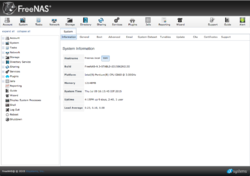FreeNAS
| FreeNAS | |
|---|---|

|
|
| developer | Olivier Cochard-Labbé Volker Theile iXsystems (2009) |
| License (s) | BSD ( Free Software ) |
| Current version |
11.3 from January 28, 2020 (212 days ago) |
| ancestry |
FreeBSD (11) ↳ FreeNAS |
| Architecture (s) | x64 |
| Languages) | Multilingual , including German |
| www.freenas.org | |
FreeNAS is a free operating system for network attached storage . It is based on FreeBSD and can run on x86 -compatible platforms in the 64-bit architecture.
With the upcoming version 12, FreeNAS will no longer exist, it will be merged into TrueNAS Core. The developer of TrueNAS, iXsystems, hopes that this step will result in a. a faster development time. The previous TrueNAS will be renamed TrueNAS Enterprise.
technology
FreeNAS is a minimal version of the FreeBSD operating system based on NanoBSD. The version number is based on the underlying FreeBSD version, for example FreeNAS 9.2.x is based on FreeBSD 9.2.
FreeNAS supports the ZFS and UFS file systems . The file systems Ext2 / Ext3 , FAT32 and NTFS (through NTFS-3G ) can be accessed for reading and writing, but these cannot be created via FreeNAS. The operating system is installed on a CompactFlash card or a USB stick (minimum size: 4 GB, recommended: 8 GB) and booted from it. Alternatively, a hard disk can be used, but this cannot be used as NAS storage. IP addresses and the administrative password can be configured via the console, but basic administration is carried out using a web-based administration interface over the network. An update of FreeNAS is also possible via this WebGUI.
The software contains NAS services such as CIFS (Samba), FTP , SFTP , NFS , rsync , iSCSI , SMART , AFP , Zeroconf , local user authentication, software RAID -0 / -1 / -5, RAID-Z and unison . Integration into an Active Directory is also possible.
Functions
- File systems: ZFS, UFS, FAT32, ext2 / ext3, NTFS (ZFS volumes are recommended, but require at least 8 GB of RAM for high-performance operation .)
- Protocols: CIFS ( Samba ), FTP, NFS, SSH , rsync, iSCSI, AFP and Avahi ( zeroconf ), SNMP , BitTorrent .
- GPT / EFI partitioning> 2 TByte possible.
- Boot from USB memory stick or flash memory
- Software RAID 0, 1 and 5, as well as JBOD and the unstable Geom Vinum , as well as RAID-Z1, RAID-Z2 and RAID-Z3
- Encryption of NAS storage (four algorithms are available: 3DES 168 bit, AES 256 bit, Blowfish 448 bit, Camellia 256 bit)
- HTTPS (for secure key transfer for hard disk live encryption)
- Local User Authentication (not yet fully implemented in SMB / CIFS - no permissions at folder and file level) and Windows domains
- Unison
- SMART
- UPnP (not implemented in version 8.0, again part of version 8.1)
- Web server function
- Status reports by email
- Status graphs for CPU utilization and LAN transfer rates
- Limited command line via the web interface
- Version 9 and higher support for FreeBSD jails
- from version 9.3 it is possible to boot from ZFS partitions
Hardware support
- Hardware RAID controllers : all supported by FreeBSD in the respective version
- Hard disk interfaces: PATA (IDE) / SATA , SCSI , USB (from version 8.0.1 also USB 3.0) and FireWire .
- Network cards: all WLAN and Ethernet supported by FreeBSD in the respective version .
- CPU Architectures: 64-bit x86 architecture (" x64 " , belonging to the Intel Architecture 32-bit , IA-32 ); Up to version 9 also 32-bit x86 (from i386).
history
The FreeNAS project was initiated in 2005 by Olivier Cochard-Labbé . Volker Theile joined the FreeNAS project in July 2006 and took over the project management in April 2008.
After initially using the FreeBSD distribution m0n0wall as a basis, the development team decided in September 2009 to develop FreeNAS from scratch. This led to the departure of Volker Theile, who was of the opinion that the project should switch from FreeBSD to Debian GNU / Linux at this stage . After leaving the company, he started development at coreNAS (today OpenMediaVault ). Thereupon Cochard-Labbé got back into the project and handed over the project responsibility to the company iXsystems in 2010.
Awards
- sourceforge.net - Project of the Month January 2007
- Page no longer available , search in web archives:
See also
- OpenMediaVault , similar software based on Linux
- XigmaNAS , (formerly NAS4Free) software based on BSD
literature
- Gary Sims: Learning Freenas. Packt Publishing, Birmingham 2008, ISBN 1-84719-468-0
Web links
- official website
- Project overview at SourceForge
- c't tests FreeNAS 8.02
- On September 5, 2006, the project was presented by Hak.5 in https://www.hak5.org/episodes/episode-2x02-release .
- Video tutorial "FreeNAS productive" sysops.tv episode 93 with replication and NFS with VMWare
- Storage with FreeNAS 8.0.2 (ADMIN magazine)
- Information on FreeNAS 9.x +
Individual evidence
- ↑ FreeNAS 11.3-RELEASE . (accessed on February 7, 2020).
- ↑ FreeNAS 11.3 with more wizards and community plugins . (accessed on February 7, 2020).
- ↑ Moritz Förster: From version 12.0: FreeNAS merges with TrueNAS. In: Heise online . March 6, 2020 . Retrieved June 20, 2020 .; Quote: "The provider expects faster development and better quality assurance of the system from this step."
- ↑ iXsystems' FreeNAS snapshot (English) Retrieved April 30, 2017
- ↑ FreeNAS 9.2.0-RC Available (English) Retrieved April 30, 2017
- ↑ Download FreeNAS (English). Accessed April 30, 2017
- ↑ FreeNAS Screenshots. Retrieved April 30, 2017
- ↑ a b FreeNAS Hardware Requirements (English) Retrieved April 30, 2017
- ↑ FreeNAS 9.3 boots from ZFS and simplifies installation. Accessed April 30, 2017
- ↑ FreeNAS vs NAS4Free (English). Retrieved April 30, 2017
- ↑ FreeNAS remains with FreeBSD. Retrieved April 30, 2017
